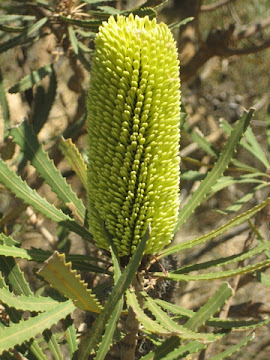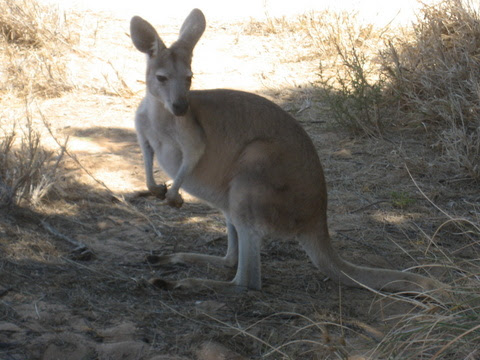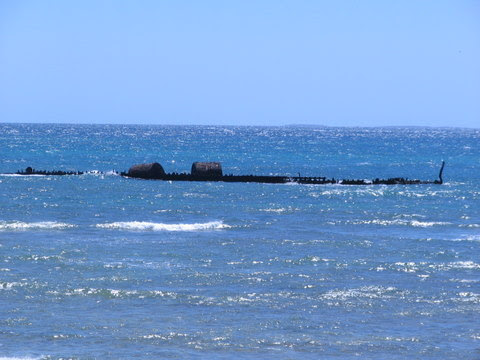After leaving Carnarvon we were back to a flat, arid, treeless landscape which instantly sent me nodding off. In no time at all, surprisingly, we were at Gladstone lookout, a mesa which had three weird cairns assembled out of rocks with messages written on them. They were a mixture of memorials to departed loved ones, autographs of travellers, a large assortment of gnomes, bras, teapots and stuffed animals! In quite a few places we've seen various collections of thongs, workboots, underwear, hard hats, postcards, photos. All except the last two were hanging on trees.

We spent the night at Hamelin Pool Station, which had the very best amenities block we've ever seen and a camp kitchen equally as good. The bird life was amazing, and together with a young family of avid twitchers with keen eyes and impressive knowledge, we saw the White-Winged and Splendid Fairy-wrens, the Red-kneed Dotterel, Common Greenshank, Eurasian Coot and a Whiskered Tern, as well as three Brown Falcons on the roof of the old barn. A great day!
Stromalite
The next morning, we went to Hamelin Pool Marine and Nature Reserve to look at the Historic Telegraph Station and the stromatolites. The stromalites are colonies of micro-organisms that resemble the oldest and simplest forms of life on earth around 3.5 billion yrs ago. They were the first life-form which produced oxygen which enabled other forms of life to evolve.
fabulous shadows cast by walkway over stromalite beds.
An old wool dray and water tank behind.... exhibits in the museum precinct at the Historic Telegraph Station.
The Shearing Hall Of Fame had an excellent collection of memorabilia relating to the pastoral and shearing industries, a huge range of steam engines, trucks and farm machinery, as well as the salvaged lifeboat from the German raider Kormoran which was responsible for the demise of HMAS Sydney II, in1941. The photographic display documenting the shearing industry and the life of local families in the 1950s was impressive. Also documented was the development of the railhead which facilitated the loading of wool onto ships for transport to Perth. Even more amazing was the fact that the museum was open and unattended!
One Mile Jetty which is currently being restored.
Nearby is the One Mile Jetty, built in 1897 to facilitate the export of wool and livestock to Freemantle. As we were walking out onto the jetty, two Aboriginal boys passed, dripping wet and carrying hand spears. They pointed to the men we could see on the beach and said they were going to fish with them. They had already caught big mullet they said. The younger boy who was about eight called the older boy, about 13, 'uncle'. We were pleased to see traditional Aboriginal culture in action as it underpins a sense of identity.
We are constantly amazed by the work done in NP and Reserve areas to protect and maintain pristine areas, while at the same time encouraging tourists to explore and enjoy them. The signage, amenities and information available is remarkable. Our annual Western Australia NP Pass, which cost a mere $50, gives us access to every NP in the state, and is well worth the expense. Camping fees within the parks are $5 pp pn, for seniors or $7pp. + $11 park entry without an annual or seasonal pass.
Today, we drove to Denham, stopping on the way to look at a few bush campsites we'd heard about along the coast and then went to Eagle Bluff. There is a boardwalk high above Shark Bay from which you can sometimes see Dugongs, rays and sharks swimming above the vast seagrass beds, but, unfortunately, it was so windy we were almost blown off the face of the planet and retreated to the car!
We also stopped to look at Shell Beach which consists entirely of shells to a depth of 10 metres. The most interesting thing was the electric fence crossing the isthmus which Is designed to keep feral animals out of the Francois Peron NP. There is a considerably successful programme of eradication of goats, rabbits, cats and foxes and reintroduction of threatened native species such as the bilby.
Denman is a pretty, seaside town with a Visitors Centre where we obtained all the information we needed for entry to Monkey Mia and the Francois Peron NP.
We bought a few supplies and drove to Monkey Mia. The resort has a lot of accommodation and tour options, restaurant, canoes for hire, shop and attractive beach with a jetty. There is a no go zone for boats and swimming where the dolphins are fed daily.
The next morning the beach was lined with tourists waiting for the dolphins to come in for the first feeding session of the day. Eventually, there were six which rolled, smiled and performed for the tourists and gratefully accepted the fish on offer.
After packing up and vacating the caravan park, we went on a catarmaran cruise for 2.5hrs, spotting dolphins, dugong and turtles. We saw a lot of dugongs for the first time in the wild. They surface briefly for air and then continue feeding on the extensive sea grass beds which occur in this area. Some of them were sleeping and looked like large, blubbery, brown lumps on the surface of the sea.
Our captain ....... Left foot on accelerator and right foot on steering wheel. Head stuck out wildlife spotting!!!!!!
The cruise also took us to a working pearl farm where we tasted pearl meat for the first time. It was surprisingly sweet. We saw the delicate the work of seeding the pearls, where the seeder opens the shell with special spreaders, then uses a scalpel to cut a small slit in the flesh where the seed is implanted. Over a period of time the seed is covered with nacre (mother of pearl), as the oyster tries to get rid of the foreign seed. A round pearl takes considerably longer to form than a blister pearl. That is the main reason why blister pearls are less expensive.

We planned to go into The Francois Peron NP but decided against going further than the homestead because the conditions were not suitable for trailers or vans. The strong, constant winds were also unpleasant. We backtracked to Denman to the visitors Centre for a camping permit and went to Eagle Bluff for the night. It was a bit protected in behind the dunes and we had no sooner set up, than the family from the night before arrived. They told us they got bogged on the way into the Francois Peron NP and had to dig themselves out of the sand, so they turned back. It was great to have some company and people to share some of the vanilla slice I'd made. They have 8yr old twin girls and an 11yr old boy.
Eagle Bluff campsite.
The wind dropped the next morning and we spent a pleasant few hours on the beach with nary a soul to be seen. Bliss! We revisited Eagle Bluff and saw huge manta rays and at least 10 sharks at one count in the waters below. No wonder it's called Shark Bay and lucky we were swimming/lolling in ankle deep water only, just before.
After lunch we covered a bit of distance and free camped at Nerren Nerren under a large shady tree, about 120kms short of Kalbarri.
Cards score: Glenn 14 Jenni 18





















































